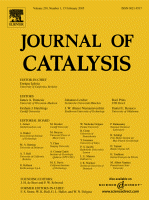"Acidic Degradation of Zeolite Catalysts in the Course of Aromatic Chlorination Using Sulfuryl Chloride"
Diano Antenucci, Lionek Delaude, André-Mathieu Fransolet, and Pierre Laszlo
 |
source: Journal of Catalysis
year: 1992
volume: 135
first page: 92
last page: 98
doi: 10.1016/0021-9517(92)90271-I
|
Abstract: The structural changes of two faujasite type zeolites in the course of aromatic chlorinations by sulfuryl chloride, SO2Cl2, were investigated by X-ray powder diffraction. Both catalysts examined, the NaX zeolite, which promotes catenar side-chain chlorination, and the ZF520 zeolite, which promotes nuclear electrophilic chlorination, are strongly altered in the acidic reaction medium (hydrochloric acid and sulfur dioxide are evolved continually as the reaction proceeds). In the presence of residual humidity, progressive dealumination of the ZF520 catalyst occurs without destruction of the zeolite framework. It gives rise to the formation of an alum type structure, for which the molecular formula (H3O)Al(SO4)2.12 H2O has been suggested. Rapid degradation of the NaX zeolite is accompanied by the formation of sodium chloride and of the sodium aluminium sulfate hexahydrate, NaAl(SO4)2.6 H2O. These compounds indeed catalyze the side-chain chlorination of toluene by SO2Cl2. Under water exclusion, structural degradation of both zeolites is slowed down; formation of hydrated sulfates is prevented; however the efficiency of the catalysts is also reduced.
[Full Text] [<< Previous Article] [Back to the List of Publications] [Next Article >>] l.delaude@ulg.ac.be